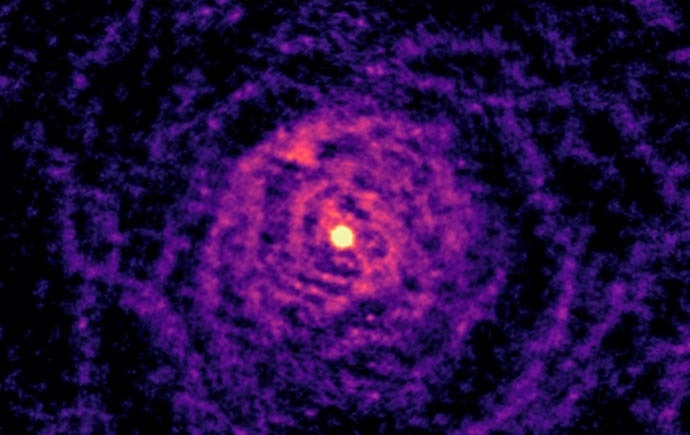Equipped with the potent ALMA telescope array in Chile, a group of multinational scientists have uncovered the cosmic riddles around a dying star, exposing a complex celestial dance molded by peculiar chemistry.
 The ALMA telescope shows how the gas around the dying star in W Aquilae has been shaped by interactions with a sunlike companion star. Both stars are located in the bright central region of this image. Image Credit: ALMA
The ALMA telescope shows how the gas around the dying star in W Aquilae has been shaped by interactions with a sunlike companion star. Both stars are located in the bright central region of this image. Image Credit: ALMA
The groundbreaking study, which was published in Nature Astronomy, illuminates the orbit of a cool red giant star in its last stages of life, revealing its outer layers in a spectacular stellar wind.
During a fascinating investigation of a star’s dying phases, scientists discovered unusual chemical emissions on one side of the star—a cosmic oddity that suggests a hotter partner star might be involved.
Once we noticed the peculiar silicon nitride emission on one side, we knew something extraordinary was unfolding.
Dr. Taïssa Danilovich, Study Lead Author and Australian Research Council (ARC) DECRA Fellow, School of Physics and Astronomy, Monash University
This cosmic performance is taking place in the W Aquilae system, where a longer-lived sunlike star and a fading star share the same cosmic stage. The details of their orbit were still shrouded in cosmic mystery up until now, with only the possibility that it could take centuries to fully understand.
Nevertheless, the study’s most recent findings provide a startling explanation: a very elliptical orbit that takes millennia to complete one captivating cycle.
Hydrodynamical models were used by the study team to interpret how the sunlike companion affected the stellar wind of the dying star. These patterns, which appear as concentric rings when viewed from the side, were vividly verified by ALMA data and were not only theoretical.
The scientists deciphered the mysteries of star movements with the help of historical discoveries from the Hubble Space Telescope and observations from the SPHERE instrument on the Very Large Telescope of the European Southern Observatory.
The ramifications go beyond W Aquilae’s cosmic stage. The study develops a novel method for utilizing ALMA to find chemical traces left behind by previous stellar contacts. This methodology holds the potential to identify the undiscovered partners of other mysterious fading stars that are covered in cosmic dust.
With about half of the stars in the galaxy existing in couples or triples, this study represents a significant advancement in the understanding of how stellar companions influence the lives of their planetary neighbors.
Journal Reference:
Danilovich, T., et. al. (2023) Chemical tracers of a highly eccentric AGB–main-sequence star binary. Nature Astronomy. doi:10.1038/s41550-023-02154-y